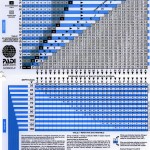As a physical oceanographer, I go to a lot of conferences, talks, seminars and lectures where a fellow scientist shows a visualization. And so many are FRICKIN’ AWESOME. I get all excited and gesture wildly. Everyone else in the audience gets all excited and gestures wildly. It’s a gesture wildly-fest that sparks great science discussions/debates inciting more wild gesturing!
But what happens to these visualizations after seminar ends? Some are posted online, while many are not. Well this is my tiny mission to change all that.
Introducing Visualization Vednesdays! I’ll be highlighting short movies made by professional scientists and talking a little bit about the science behind the graphic. I’ll be focusing on physical oceanography cause they be my peeps, but if you know of another great ocean visualization please send it my way. However, there are some rules. These videos have to be made by the researchers themselves. No graphics department, just the pure creativity of scientists. Because really, who doesn’t enjoy beautiful things?
As an internal waves junky, of course my first video will be of internal waves. As the tides slosh back and forth over the narrow Strait of Gibraltar, the water must go up and over the shallow sill between Europe and Africa that separates the Atlantic Ocean and the Mediterranean Sea, GENERATING GIANT WAVES!!!! Crests are formed on the left hand side of the sill and then propagate to the right. And you can even see the waves getting all squished as they go through the narrow constriction that is the Strait of Gibraltar.
But wait, I give you more! The view from INSIDE THE OCEAN. As flow sloshes over the hump, waves are generated at the rainbow interface of the fresher surface layer (blue) with the saltier deep layer (red). And it is a gorgeous train of waves that heads to the right. A bunch of wiggles heading eastward where they will eventually break somewhere in the Mediterranean. These wiggles are actually what make it somewhat perilous to be a submarine crossing through the Strait.
Finally, these 2 videos show the same phenomena, but were actually done with two different models by Gianmaria Sannino a researcher in Italy. The first uses the MIT General Circulation Model (MITGCM) (full disclosure: this site is where I found this visualization), while the second uses the Princeton Ocean Model (POM). Both are great models and are widely used by the oceanographic community.






Beautiful!
I also have a contribution: http://youtu.be/SMuWdWakNWQ
This is a test of a particle tracking code that I wrote, using a MOM4 integration. The bottom panel shows time (in years) versus depth (in meters). Even though the graphics are not very pretty — this was done in Python back in 2006 — if you pay attention you can see some interesting phenomena like gyres, the retroflection of the North Brazil Current, upwelling, and more. Two things that I like:
1. My favorite is the bifurcation of the southern branch of the South Equatorial Current into the Brazil Current and the North Brazil Current. The latitude of the bifurcation changes with depth, and you can see this when the particle is carried by the sSEC in two different moments.
2. In this animation time passes at a variable rate. You can see that when the particle goes to deeper waters the it will stay there for centuries moving very slowly, while on shallow waters it will move a lot while the time almost doesn’t change.
At some point in testing my code the particle managed to cross from the Atlantic to the Pacific over Panama. No, it didn’t cross the canal; my grid was broken so there was a connection between the two oceans there. :-P
This is a great idea. Thanks for doing this!
I am working on the idea of using mapping with oral storytelling. some of these maps would be great, possibly, when telling stories of The Odyssey, for example. Or any other tale that involves the sea.